Ellen Southard
Ellen Southard was an American full-rigged merchant ship from Bath, Maine that was built in 1863 by prominent shipbuilder T.J. Southard. She plied international trade routes for twelve years, calling at ports as far away as Sydney.
 Watercolour painting of Ellen Southard wreckage lying on Crosby Sands, Liverpool on 11 October 1875 | |
| History | |
|---|---|
| Namesake | Ellen J. Southard, daughter of T.J. Southard[1][2] |
| Owner | Thomas J. Southard[3] |
| Builder | T.J. Southard, Richmond, Maine |
| Launched | 1863[3] |
| Homeport | Bath, Maine[4] |
| Identification | 8229[4] |
| Fate | Wrecked at Liverpool, 27 September 1875 |
| General characteristics | |
| Class and type | Full-rigged ship |
| Tonnage | 828 tons |
| Length | 159 ft (48 m) |
| Beam | 33 ft (10 m) |
| Draught | 20 ft (6.1 m) |
| Depth of hold | 23 ft (7.0 m) |
| Propulsion | Sail |
| Crew | 15 |
On 27 September 1875, the ship wrecked in the mouth of the Mersey River at Liverpool during a hurricane-strength storm. Shore-based lifeboats crewed mainly by volunteers set out from several lifeboat stations to the aid of the distressed ship after it foundered on a sandbank. One of the lifeboats capsized in heavy seas after picking up the ship's crew, resulting in nine people from the ship as well as three rescuers losing their lives.
Following the advice of the US consul at Liverpool, the United States Congress recognised the acts of bravery by issuing 27 Gold Lifesaving Medals to the lifeboat men who attempted to save her crew, after a two-year delay during which US law first had to be changed to allow the newly instituted medals to be awarded to non-US citizens. Debate about lifeboat designs continued for many years until a self-righting design was eventually adopted.
Description
.jpg.webp)
Ellen Southard was built in 1863[3][5][6] in Richmond, Maine, by prominent local shipbuilder T. J. Southard.[7] She was named after the builder's daughter, Ellen, to whom he also gave a one-sixteenth share of the vessel.[8][9][lower-alpha 1] The ship was classified "A1" in the Lloyds Register, meaning that her hull and fittings were of the highest grade.[6]
Ellen Southard plied international trade routes from her homeport in Bath, Maine, with visits documented in ports as far away as Sydney, Australia.[10] In 1864, she recorded the longest duration voyage of any ship transporting railway locomotives from the east to the west coast of the United States. The ship took 205 days to complete the passage after she was delayed for 48 days by unfavourable winds off Cape Horn.[11]

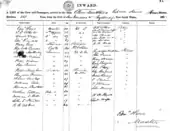
In June 1867, shortly after departing Hong Kong for California with 360 Chinese passengers, Ellen Southard's master, Captain Howe, died at sea.[12] His wife took charge of the ship, but the passengers and crew became mutinous when the water supply dwindled; she resorted to using a revolver to keep them at bay until a passing ship encountered Ellen Southard adrift 80 miles (130 km) from Santa Cruz, California.[12][13] The captain raised the alarm upon reaching port, whereupon the USRC Wayanda went to the assistance of the distressed ship.[14][15]
Loss
On 12 August 1875, Ellen Southard set sail for Liverpool in England from Saint John, New Brunswick, under the command of Captain Henry Woodworth[16][lower-alpha 2] with a load of tropical deal, a type of softwood.[17] The captain's wife and fifteen crew members were on board. She was approaching the River Mersey on 26 September 1875 when the most violent storm to hit the region in 36 years struck. It began at 9 pm, increasing rapidly in intensity to hurricane strength by midnight; the storm remained at this level until 2 am.[16] Buildings were damaged ashore, with two people killed by falling masonry, while on the river, vessels were blown from their moorings and damaged by colliding with one another or with the quays.[18]
Ellen Southard had rounded the northern tip of Wales, passing Point Lynas at 1 pm on the day of the storm. After receiving the pilot on board, she was taken in tow by the steamtug United Kingdom under the command of Captain Griffiths for the final leg of her journey into the port of Liverpool. By 9 pm, conditions had become very stormy, and her sails were taken down;[19] by the time she reached Formby, the ship could no longer be steered, and the tow line was also lost.[19] Ellen Southard dropped her anchors, but they did not hold in the ever-strengthening storm. Finding that it was unable to offer further assistance, the tug set off for Liverpool with the purpose of returning with a lifeboat, but was soon grounded, thereby leaving the stricken American ship to fend for herself.[19] By midnight when the storm reached its peak, Ellen Southard was dismasted and grounded on Jordan Flats[lower-alpha 3] about a mile from Crosby lighthouse. The waves crashed heavily on her, and she started to break up as she thumped on the sandbank.[6] The crew were unable to signal for assistance until first light as the vessel did not carry any signal flares[20] – in the interim, they lashed themselves to what remained of the ship to prevent being swept away by the heavy sea.
Lifeboat disaster
At just after 5 am, the Mersey Docks and Harbour Board's lifeboat station received a telegram stating that a ship was in distress. Nine minutes later, the three-year-old tubular lifeboat[lower-alpha 4] set out with fourteen volunteers under the command of Captain James Martin.[16] The steam tug Rattler initially took the Liverpool boat in tow, as the properties that made it suitable as a lifeboat also made it very heavy to row. At approximately the same time that the Liverpool lifeboat was departing Mersey Docks, the New Brighton, Formby and Hoylake boats also got underway,[22] with the New Brighton RNLI boat in tow behind Sprindrift. The hurricane had abated somewhat, but the sea was still heavy, which made the rowers' work very difficult in shallower water where the tugs could no longer assist them.[16]
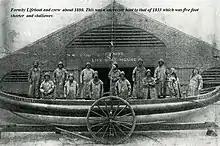
When the Liverpool lifeboat came alongside the wreck, some of those aboard were able to jump directly into the lifeboat, but others had to be roped in. The steward, who was the last person on the doomed ship, decided to go back to recover his bag; minutes passed while the people in the lifeboat waited anxiously until he eventually re-appeared and joined them.[16] Seventeen people including the pilot were taken onto the lifeboat. Finally, the lifeboat was able to get clear of the wreck and navigate its way through the floating debris to start its return journey to the dock. The New Brighton lifeboat was still about 500 yards (460 m) away when the Liverpool boat left the wreck, and thus coxswain Richard Thomas turned her around once it became apparent that everyone had already been taken off the ship successfully.[16]
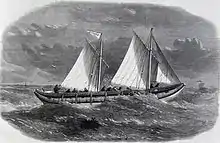
The wind, tide and sea made it impossible for the Liverpool lifeboat to link up with the waiting tug for another tow, so the men were forced to start rowing home. About twenty minutes later, as the boat reached the relatively safer waters of the channel, the master elected to raise the foresail to help steady the vessel.[23] People in the lifeboat were still congratulating themselves on their lucky escape, when Captain Martin noticed a huge wave "like a high wall" approaching.[23] He instructed everyone to hold on, fearing that someone might be washed overboard. However rather than breaking over the boat, the wave lifted it and flipped it over.[23][24][16] The boat was not self-righting, so the remaining survivors were left clinging desperately to the upturned boat. Rattler's master witnessed the incident and signalled to the New Brighton lifeboat, Willie and Arthur, which promptly turned around to come to the rescue.[25][23] The men who were on the capsized boat directed the New Brighton lifeboat to first assist three others who were in more danger clinging to bits of wood in the sea.[23] After picking up the survivors and one casualty, the New Brighton lifeboat was taken in tow by Rattler, which brought her back to New Brighton. Six of Ellen Southard's crew, the captain and his wife, as well as the pilot and three lifeboat men from Mersey Docks drowned or died of exposure (12 fatalities in total).[24]
Labourers were employed to salvage the valuable wood that washed up on Crosby Beach; among the items found were a hat belonging to the captain's wife and a concertina belonging to one of the crew.[26] Two bodies were also seen in the water.
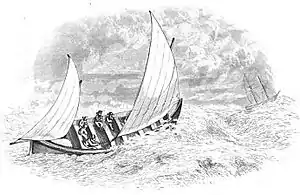
A court of enquiry was held the following month in Liverpool by the Board of Trade, and focused particularly on the roles of the captains in the tragedy as well as the design of the Liverpool lifeboat. The court found that no-one was to blame for the loss of either Ellen Southard or the Liverpool lifeboat. Captain James Martin and his crew were praised for their gallantry in getting everyone off the ship, and absolved of any blame with respect to the capsizing of the lifeboat. The lifeboat was furthermore found to be of sound design and suitably adapted to her role,[20] but debate continued for many years about the merits of the tubular design vs the self-righting one, as well as the requirement for lifeboats to be powered. [28] After twelve years of deliberation, a decision was finally made to adopt self-righting lifeboats.
Lifesaving medals

General Lucius Fairchild, the United States consul at Liverpool, wrote to his government recommending that the gallantry of the Englishmen who were involved in the rescue effort be recognised. The Secretary of State supported his recommendation[29] and the United States Congress moved to award the newly instituted[lower-alpha 5] Lifesaving Medal to the lifeboat men. A delay of 17 months followed during which legislation was enacted to allow the medals to be issued to non-US nationals.[30] Finally, in 1877, the United States government awarded first-class Gold Lifesaving Medals to the twenty-seven men of the Mersey Docks and New Brighton RNLI lifeboat station who survived the incident,[31] while the families of the three deceased lifeboat men were awarded a sum of $200.00 in gold in lieu of a medal.[30][32][33] Starting in 1877, the medal was reduced in size from 3 inches (76 mm) to 2 inches (51 mm), and its gold content reduced to 3 ounces (85 g). The medals were conferred in a public ceremony in Liverpool Town Hall on 27 February 1877 that was attended by the US Consul and the masters of most of the US ships that were in port at the time.[32][34] The coins were incorrectly engraved with the ship’s date of departure from New Brunswick (12 August) instead of the date of the tragedy (26 September).
Sir: I have the honor to transmit herewith a life-saving medal of the first class which has been awarded to you, under the authority of the provisions of the seventh section of the Act of the Congress of the United States, approved June 20, 1874, for the extreme and heroic daring manifested by you in the rescue, under circumstances of peculiar danger and difficulty, of eight persons from the wreck of the American ship "Ellen Southard," at the mouth of the river Mersey, near Liverpool.
In transmitting this offering to you, as to each member of the crew of the Life-Boat of the Royal National Life-Boat Institution stationed at New Brighton, it is proper to remark that it is the first time an opportunity has arisen for bestowing the medal of the life-saving service of this country upon subjects of a foreign nation. It was the fortune of your crew to arrive upon the scene of disaster after the Liverpool life-boat men had effected a deliverance, and been in turn subjected to a dreadful casualty, whereby nine of the persons they had rescued and three of their own number were drowned: and the remaining eight persons from the vessel and the twelve men of the Liverpool crew, clinging to the capsized boat in a fearful sea, owe their lives to you and your comrades. The extreme jeopardy and hardships you encountered upon the occasion of their rescue are deeply appreciated, and, in behalf of the United States, I beg you to accept this testimonial, provided by law in recognition of such deeds of bravery and compassion. In sending it, allow me to add the expression of the sense of the gallantry and the devotion to high human duty which marked the conduct of yourself and of your comrades upon the occasion under notice, and of the assurance that each member of your crew, in his own person, by this deed of valor and mercy, confers fresh and just honor upon the great name of England.
I have the honor to be, Sir, your obedient servant,
Charles F. CONANT, Acting Secretary of the Treasury[35]
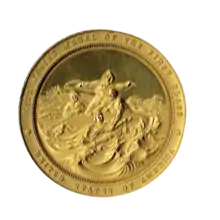
| Lifeboat | Name | Award |
|---|---|---|
| Liverpool | James Martin (Master) | Gold Livesaving Medal |
| Hugh Beard | Gold Livesaving Medal | |
| James Conley | Gold Livesaving Medal | |
| William Gregory | Gold Livesaving Medal | |
| Charles Danslow | Gold Livesaving Medal | |
| John Dolman | Gold Livesaving Medal | |
| George Lee | Gold Livesaving Medal | |
| Philip Murphy | Gold Livesaving Medal | |
| James Munday | Gold Livesaving Medal | |
| William Ruffler | Gold Livesaving Medal | |
| Samuel Richards | Gold Livesaving Medal | |
| William Stewart | Gold Livesaving Medal | |
| John Boyle (drowned) | $200 (equivalent to $5,496 in 2022) to his family | |
| James Yates (drowned) | $200 (equivalent to $5,496 in 2022) to his family | |
| Robert Moore (drowned) | $200 (equivalent to $5,496 in 2022) to his family | |
| New Brighton | R.J. Thomas (Coxswain) | Gold Livesaving Medal |
| Charles Eddington | Gold Livesaving Medal | |
| William Griffith | Gold Livesaving Medal | |
| James Godfrey | Gold Livesaving Medal | |
| W. Jones | Gold Livesaving Medal | |
| John Dean | Gold Livesaving Medal | |
| James Duncan | Gold Livesaving Medal | |
| James Harvey | Gold Livesaving Medal | |
| Robert Lucas | Gold Livesaving Medal | |
| Thomas Maloney | Gold Livesaving Medal | |
| Charles MacKenzie | Gold Livesaving Medal | |
| John Powell | Gold Livesaving Medal | |
| John Robinson | Gold Livesaving Medal | |
| E. Crabtree | Gold Livesaving Medal | |
| Henry Williams | Gold Livesaving Medal |
page
Notes
- Other shareholders were T.J. Southard himself (5⁄16), his son (2⁄16), his second daughter (1⁄16), Benjamin Sewall (4⁄16), and her first master, Captain Edward Howe (3⁄16).[8][9]
- Some sources report his name as Captain Woodward
- A sandbank that existed at the time at the present day location of Taylor's Bank
- A lifeboat design patented by Henry Richardson, that comprised two cylindrical tubes with multiple watertight compartments. Tubular lifeboats were valued for their sturdiness and safety in rough seas.[21]
- The medal was created in 1874 and first awarded in 1876.
Footnotes
- Sutherd 1977.
- Records-1882, p. 46.
- Preble, Partridge & Raymond 1879, p. 62.
- Treasury-1871, p. 77.
- Records-1882, p. 5.
- Burnley-1875, p. 7.
- Fairburn 1945, p. 3315.
- Records-1882, p. 116.
- Records-1882, p. 162.
- NSW-1865.
- Railroad History-1999, p. 19,26.
- Hill 1869, p. 334.
- Hopkins 1877, p. 1B.
- NYT-1867.
- NYExpress-1867.
- Mercury-1875a, p. 1.
- Commons-1876, p. 322.
- Rockhampton-1875.
- Mercury-1875b, p. 6.
- Mercury-1875c, p. 5.
- Folkard 2012, pp. 126–129.
- Rockhampton-1875, p. 3.
- Lifeboat-1875, p. 416.
- Loubat & Jacquemart 1878, p. 446.
- Mercury-1875d, p. 8.
- Worrall 2009, p. 287.
- Folkard, Henry Coleman. The sailing boat: a description of English and foreign boats (Longmans, Green & Co., 1870) pp. 113-130.
- Benjamin 1886, p. 7.
- Congress-1877, p. 830.
- NYT-1877a.
- NYT-1877b.
- Mercury-1877, p. 8.
- Methley 1912, p. 119.
- USLSS-1900, p. 217.
- Loubat & Jacquemart 1878, pp. 715–716.
References
- Annual Report of the United States Life-Saving Service (USLSS). United States Life-Saving Service, Treasury Department. 1900. Retrieved 30 December 2012.
- "Secretary of War Got Lifesaving Medal: Risk Death to Save Drowning Man-Other Notable Rescues Recognized by Government" (PDF). The New York Times. 16 October 1877. Retrieved 20 October 2012.
- ""Ellen Southard" and the Liverpool Lifeboat No. 1". Accounts and Papers of the House of Commons. House of Commons, Parliament of Great Britain. 1876. Retrieved 30 December 2012.
- Fairburn, William Armstrong (1945). Merchant Sail. Vol. V. Fairburn Marine Educational Foundation. Retrieved 30 December 2012.
- "Gold Medals for Brave Men; America's Recognition of True Gallantry: Shipwrecked Sailors Rescued by Life-boats's Men" (PDF). The New York Times. 5 May 1877. Retrieved 20 October 2012.
- Hill, D.H (February 1869). "Women, and the Lives of Women". The Land We Love. J. P. Irwin. 6 (4): 334. Retrieved 30 December 2012.
- Hopkins, C.T (1877). "California Wreck Register for 1871 to 1876, inclusive" (PDF). San Francisco. Retrieved 30 December 2012.
- Loubat, Joseph Florimond; Jacquemart, Jules-Ferdinard (1878). The Medallic History of the United States of America, 1776–1876. Vol. 1. New York, The author. Retrieved 30 December 2012.
- Methley, Noël T (1912). The Life-boat and its Story. Sidgwick & Jackson Ltd. p. 119. Retrieved 30 December 2012.
- "Annual Report of the Secretary of the Treasury on the State of the Finances for the Year 1876". Congressional Edition. United States Government Printing Office. 1752. 1877. Retrieved 30 December 2012.
- List of Merchant Vessels of the United States, with the Official Numbers and Signal Letters Awarded to Them. Bureau of Statistics, United States Treasury. 1871. Retrieved 30 December 2012.
- Preble, George A.; Partridge, F.S.; Raymond, John H. (1879). A Complete Schedule of Vessels Built and Registered in the District of Bath, Maine, Commencing at 1783, Giving Rig, Name, Tonnage, Where Built, First Master, Registering Owner, and Hailing Port. Fen G. Barker & Co. Retrieved 30 December 2012.
- Sutherd, Calvin E (October 1977). "History of the Suthards" (PDF). Boca Raton, Florida: Page Public Library, Luray Virginia. Retrieved 30 December 2012.
- Worrall, Dan Michael (2009). The Anglo-German Concertina: A Social History. Vol. 1. Dan Michael Worrall. ISBN 978-0982599600. Retrieved 30 December 2012.
- "Mariners and Ships in Australian Waters: Ellen Southard". State Records Authority of New South Wales. Archived from the original on 4 March 2006. Retrieved 30 December 2012.
- "From the Pacific Coast – Shipment of Treasure and Flour – Shipping Intelligence – Markets" (PDF). The New York Times. 14 June 1867. Retrieved 23 October 2012.
- Huffman, Wendell W. (1999). "Railroads Shipped by Sea". Railroad History. Railway and Locomotive Historical Society. 180 (180): 6–30. JSTOR 43522103.
- "Destructive Gale". Rockhampton Bulletin. Vol. XVIII, no. 2395. Queensland, Australia. 26 November 1875. p. 3. Retrieved 18 May 2017 – via National Library of Australia.
- "From San Francisco" (PDF). New York Evening Express. June 1867. Retrieved 28 October 2012.
- Records 1882–1885. Vol. 7. Washington: United States Court of Commissioners: Alabama Claims. Retrieved 30 December 2012.
- "Terrific Gale". Burnley Gazette. 2 October 1875. Retrieved 21 October 2012. (subscription required)
- Benjamin, Ludwig (17 December 1886). "The Lifeboat Disasters: To the Editors of the Liverpool Mercury". Liverpool Mercury. Retrieved 31 October 2012. (subscription required)
- "Terrible Storm in Liverpool: Great Loss of Life & Great Destruction of Property". Liverpool Mercury. 28 September 1875. Retrieved 2 November 2012. (subscription required)
- "Gallant Lifeboat Services: Presentation of Medals to the Liverpool Boatmen". Liverpool Mercury. 21 April 1877. Retrieved 3 November 2012. (subscription required)
- "The Lifeboat Disaster: Board of Trade Inquiry". Liverpool Mercury. 19 October 1875. Retrieved 3 November 2012. (subscription required)
- "The Lifeboat Disaster: Judgement of the Court". Liverpool Mercury. 23 October 1875. Retrieved 4 November 2012. (subscription required)
- "The Shipwreck off the Port: Inquest on the Lifeboat Man". Liverpool Mercury. 30 September 1875. Retrieved 4 November 2012. (subscription required)
- "The Life-boat". IX (98). Royal National Lifeboat Institution. 1 November 1875. Retrieved 30 December 2012.
{{cite journal}}: Cite journal requires|journal=(help) - Folkard, Henry Coleman (2012). The Sailing Boat. Books on Demand. ISBN 978-3954272136.